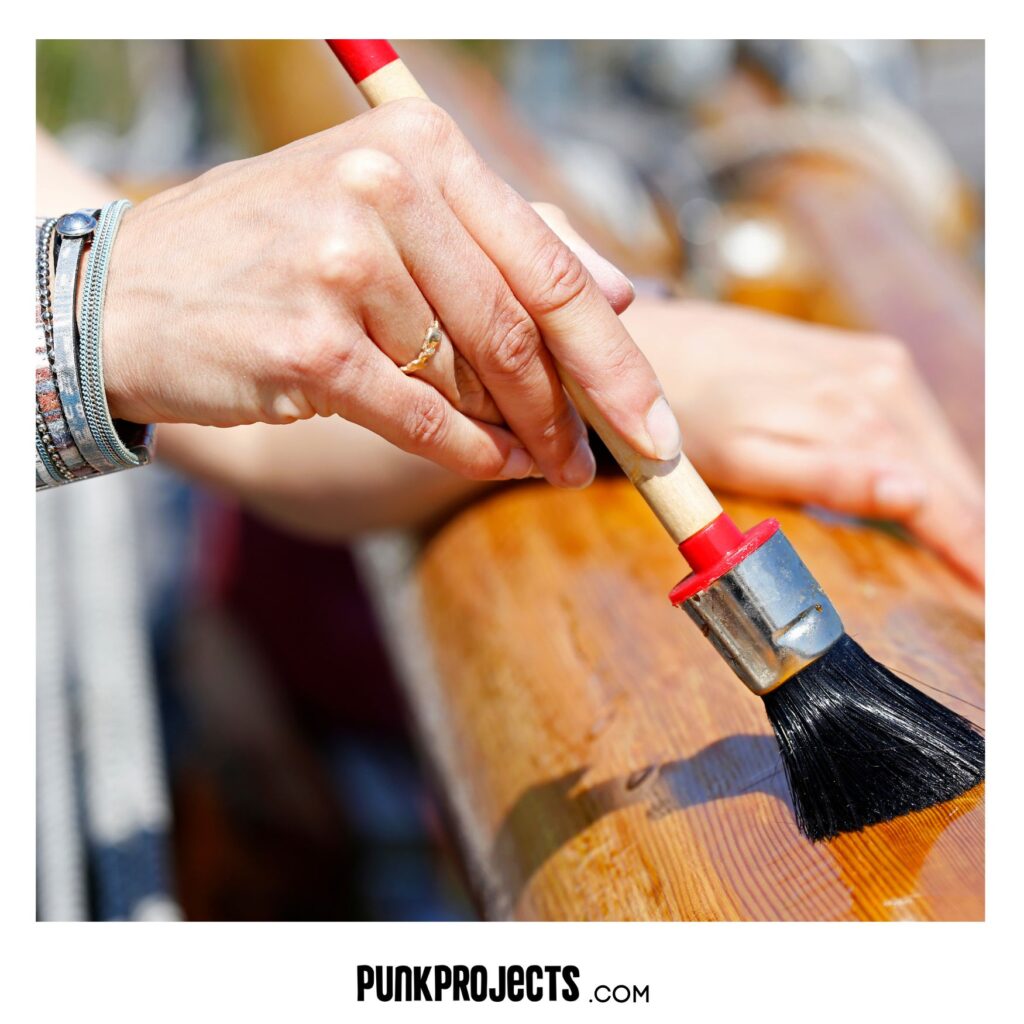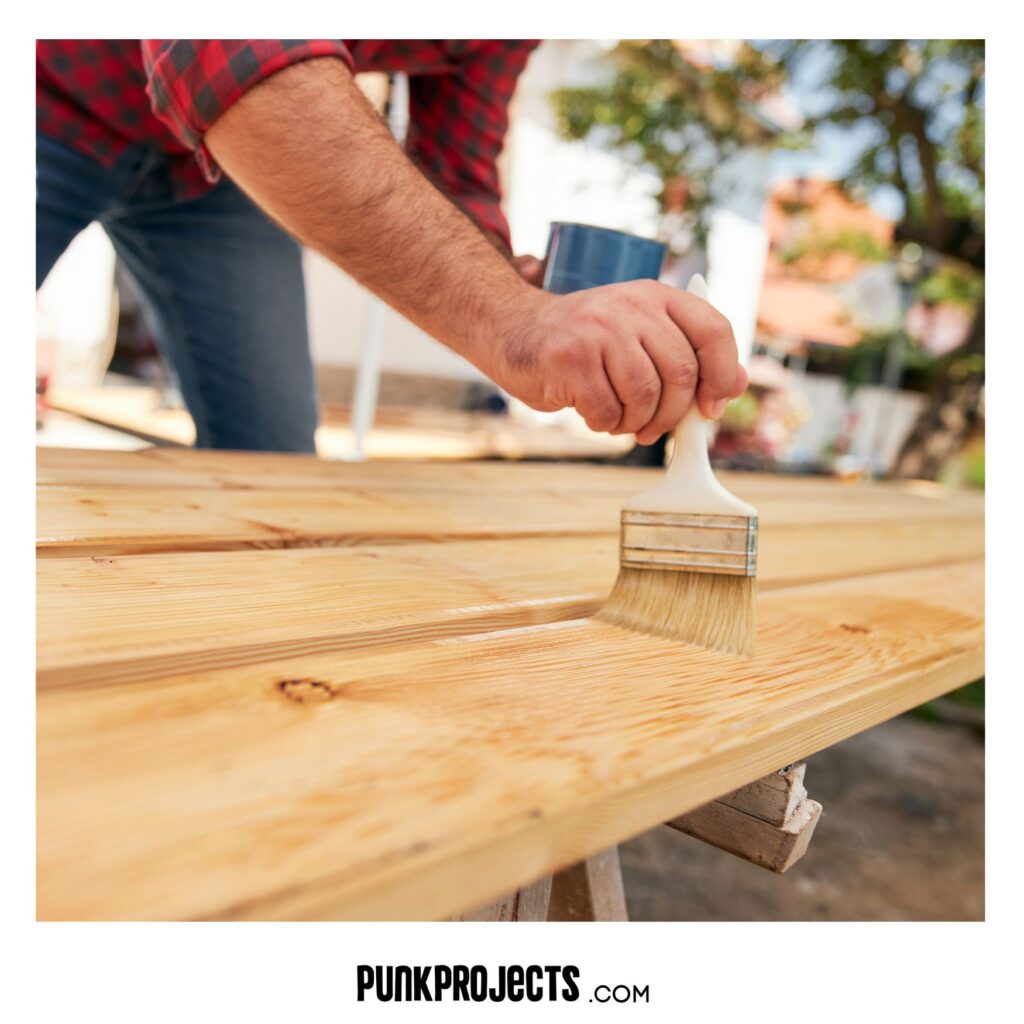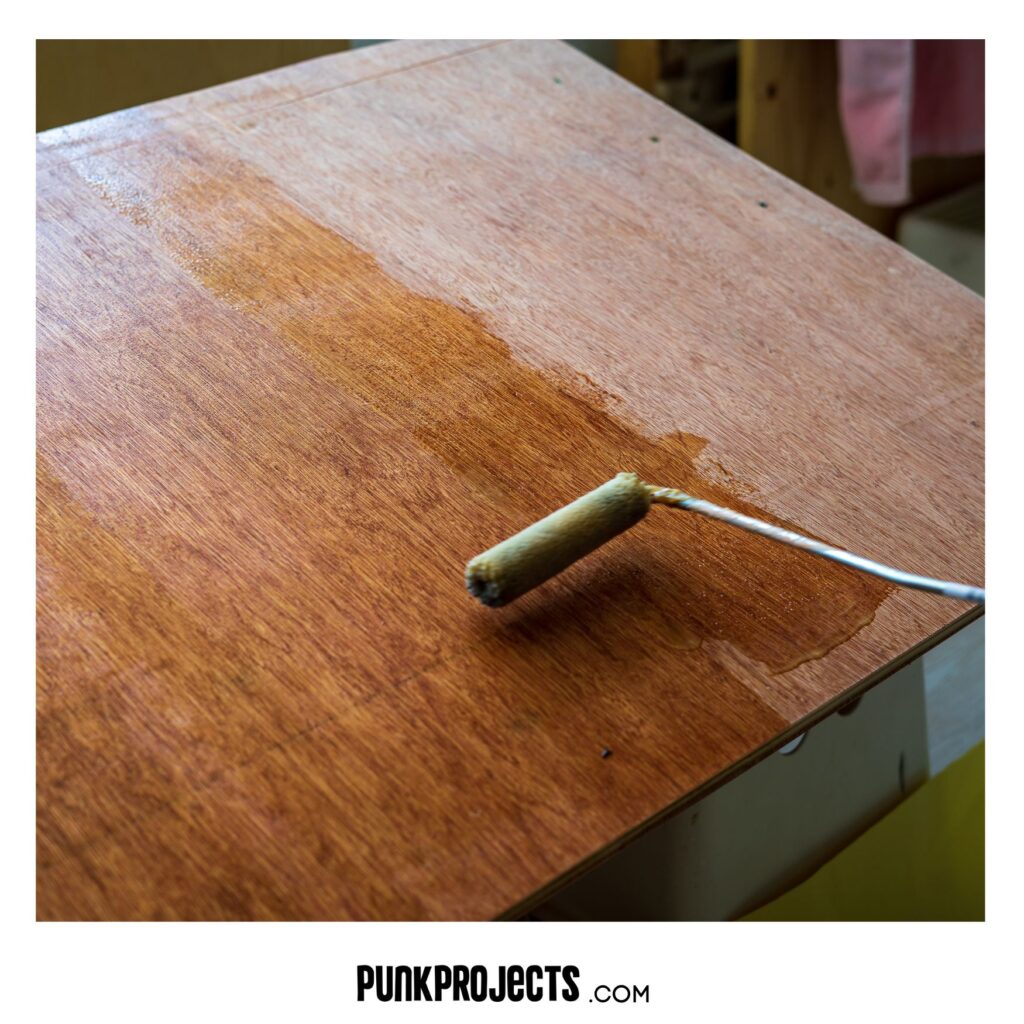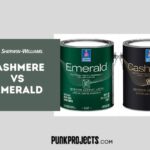Curious about spar Spar Urethane vs Polyurethane? Think of them as the “cool kids” in the world of wood finishes. In this blog post, we’re here to demystify these finishes for you. We’ll chat about what makes each one tick, where they shine, and any quirks you should know.
Whether you’re a DIY enthusiast or a woodworking newbie, understanding spar urethane and polyurethane will be your secret weapon for nailing that perfect finish. Ready to unravel the magic of these wood protectors? Let’s jump right in!
What is Spar Urethane?

To achieve a clear understanding of what spar urethane entails, dive into the section “What is Spar Urethane?” This section will illuminate the key aspects of spar urethane, along with its sub-sections: description and characteristics, as well as its common uses.
Description and characteristics
Spar urethane is a clear varnish that boosts the look of wood surfaces. It brings long-lasting protection against wear and tear, moisture, UV rays, and scratches. Moreover, this varnish adds an attractive sheen to the wood. It highlights the natural grain pattern, creating an impressive end result.
Recently, a buddy of mine redid his wooden deck with spar urethane. He couldn’t believe the transformation it made – not only did it protect from the sun and rain, but it also gave a glossy finish. Now, his deck looks brand new and will stay that way for years. Spar urethane really showed how its protective and enhancing qualities can make a huge difference!
Common uses
Spar urethane is popularly utilized for preserving wood surfaces. This includes outdoor furniture, doors, and trim. It is resistant to weather exposure, UV rays, and moisture damage.
It is a go-to material for many industries due to its strong durability and protective traits.
| Common Uses | Description |
|---|---|
| Outdoor Furniture | Spar urethane shields outdoor furniture from destructive weather. |
| Doors | It prevents damages and boosts their longevity. |
| Trim | A layer of protection against wear and tear. |
Moreover, spar urethane is used to protect wooden boats from water penetration. It’s also employed in the restoration of antique furniture to accentuate its natural beauty.
Recently, a carpenter named Mark utilized spar urethane to restore an old rocking chair. He found that the material not only preserved it, but also heightened its rustic charm. His customer was amazed by the remarkable transformation.
Spar urethane has a broad range of uses, making it an ideal option for professionals looking for reliable protection and a touch of style to their wooden projects.
What is Polyurethane?

To understand what polyurethane is and its practical applications, delve into its description and characteristics, as well as its common uses. Explore the distinctive features and qualities of polyurethane, and discover its various practical applications in different industries and everyday life.
Description and characteristics
Polyurethane is a multi-functional material, with remarkable traits. It is found in foam, coatings, adhesives and sealants. Its benefits include high elasticity, strength, resistance to abrasion and chemicals, good insulation and great adhesion.
See the table below for the features of polyurethane:
| Characteristic | Description |
|---|---|
| Flexibility | Polyurethane is conveniently flexible, ideal for applications needing elasticity. |
| Durability | It is incredibly long-lasting, able to handle wear and tear for a lengthy time. |
| Chemical Resistance | Polyurethane is resistant to chemicals such as solvents, oils and acids. This enhances its endurance in harsh environments. |
| Thermal Insulation | With its great insulation, polyurethane is the perfect material for insulating buildings and refrigeration systems. |
| Adhesion | Polyurethane has powerful adhesive powers, allowing it to bond with different materials like wood, metal, plastic and fabrics. |
Apart from these characteristics, polyurethane also has low water absorption capabilities and can be changed into various shapes due to its flexibility.
In conclusion, the wide-ranging features of polyurethane make it an essential material in numerous industries globally.
Common uses
Polyurethane is a versatile material, used across many industries such as construction, automotive, furniture, and more. Here are some common uses:
| Industry | Common Uses |
| Construction | Building insulation, sealants, adhesives |
| Automotive | Car seat padding, bumpers, coatings |
| Furniture | Flexible and rigid foam for cushions, mattresses, coatings |
| Footwear | Sole materials, shoe inserts |
| Elastomers | Dynamic applications such as conveyor belts and roller wheels |
Polyurethane is also used in packaging materials, such as foam inserts for fragile items. To make the most of it, you should handle and store it correctly.
Also, adhere to recommended application techniques and curing times. Lastly, regular inspection and maintenance will help prolong its life. By following these tips, you can make the most of polyurethane’s properties.
Comparison of Spar Urethane and Polyurethane

To compare spar urethane and polyurethane, explore their similarities and differences. The similarities highlight common features, while the differences shed light on unique characteristics.
Similarities
To compare spar urethane and polyurethane, let’s take a closer look at their similarities. Here’s a summary:
| Attributes | Spar Urethane | Polyurethane |
|---|---|---|
| Durability | Yes | Yes |
| Waterproof | Yes | Yes |
| Scratch-Proof | Yes | Yes |
| Protection | Yes | Yes |
Both spar urethane and polyurethane are renowned for their durability. They can stand the test of time and protect your surfaces for years to come.
Plus, both coatings are waterproof. They form a reliable barrier and prevent damage caused by liquid exposure.
What makes spar urethane and polyurethane unique is their scratch-proof ability. These finishes resist scratches, keeping your surfaces looking flawless.
Lastly, both coatings offer amazing protection. The protective barrier against UV rays prevents discoloration and deterioration.
So, consider these shared points to determine which coating option is best for you. Get the benefits of either spar urethane or polyurethane today!
Differences
Spar urethane and polyurethane are two popular finishes used in woodworking. Both offer different characteristics. Let’s explore!
See the table:
| Spar Urethane | Polyurethane |
|---|---|
| Offers great protection | Good durability against wear and tear |
| Formulated for outdoor use | Not ideal for harsh weather |
| Recommended for exterior woodwork | Suitable for furniture, floors, and cabinets |
| Longer drying time | Short drying time for quicker project completion |
| Less flexible film formation | Forms a flexible film for wood movement |
Spar urethane is great for outdoor use. It provides protection against harsh weather. However, it takes longer to dry. Polyurethane is versatile. It’s suitable for multiple surfaces and dries faster.
It’s essential to consider the drying time. This could affect the project timeline.
Appearance and finish
It’s time to compare spar urethane and polyurethane. Let’s look at key differences.
Firstly, their visual appearance. Spar urethane gives a warm, amber tone. Whereas, polyurethane has a clear, glossy finish. This can have a huge effect on the project.
Secondly, how durable are they? Spar urethane is designed for outdoor use. It offers protection from UV rays and moisture. Polyurethane is better for indoors, and offers good resistance to wear and tear.
Thirdly, their drying time. Spar urethane takes longer due to its oil-based formulation. Meanwhile, polyurethane dries quickly as it is water-based.
Finally, flexibility. Spar urethane is more flexible than polyurethane. This makes it ideal for wood that expands or contracts with temperature changes.
Benjamin Moore paint manufacturer states that spar urethanes protect wood surfaces over time.
Durability and protection
Spar urethane and polyurethane are both great for durability and protection. Still, there are some differences which affect performance. To compare, let’s look at the table below:
| Criteria | Spar Urethane | Polyurethane |
|---|---|---|
| Water Resistance | Good | Excellent |
| UV Protection | Excellent | Good |
| Chemical Resistance | Average | Excellent |
| Scratch Resistance | Good | Excellent |
| Impact Resistance | Average | Excellent |
As seen, polyurethane generally offers better water resistance, UV protection, chemical resistance, scratch resistance, and impact resistance than spar urethane. But spar urethane still offers good performance in these areas.
For optimal durability, both require proper surface prep and multiple coats. Plus, maintenance such as recoating may be necessary for long-lasting protection.
Application and usability
Polish up your woodwork with spar urethane or polyurethane. But do you know what sets them apart? Let’s take a closer look at the key differences between these two finishes.
- Durability
– Spar Urethane: Good resistance to sunlight, water, and temperature.
– Polyurethane: Excellent protection against wear, chemicals, and scratches. - Usability
– Spar Urethane: Ideal for outdoor projects.
– Polyurethane: Versatile for use on various surfaces. - Drying Time
– Spar Urethane: Slower drying time than polyurethane. - Maintenance
– Spar Urethane: May require occasional touch-up in high-wear areas.
– Polyurethane: Minimal maintenance due to its robust protective coat. - Cost
– Spar Urethane: Relatively expensive.
Spar urethane is great for outdoor projects because it offers better resistance to sunlight, water, and temperature. But polyurethane is better for its superior durability against wear, chemicals, and scratches. It is also more versatile.
Read also : Polyshades vs Gel Stain (Which One Should You Choose)
Advantages and disadvantages of Polyurethane

To understand the advantages and disadvantages of polyurethane, let’s discuss the benefits and drawbacks of this popular finish. Delving into the sub-sections of advantages and disadvantages, we’ll explore the different aspects you should consider when using polyurethane as a solution for your woodworking projects.
Advantages
Polyurethane is a mighty material with lots of benefits. Its durability is top-notch, providing products with long-lasting quality. Plus, its insulation capabilities ensure stable indoor temperatures and soundproofing between rooms.
Moreover, its versatility means it can be used in many applications, ranging from foam mattresses to car seats. Furthermore, polyurethane is resistant to chemicals and water, making it suitable for many outdoor uses.
However, bear in mind that the curing process of this material can release fumes that can be dangerous if breathed in – so always make sure you have proper ventilation when working with it.
Disadvantages
Polyurethane has great advantages, but don’t forget the downsides! Weighing both sides is key before settling on this material for your project.
- Environment: Polyurethane’s production can cause harmful emissions that pollute the air.
- Durability: It usually offers long-term resistance, but can degrade when exposed to sunlight and extreme weather.
- Temperature: It’s limited temperature range can affect its performance in certain cases.
- Repair: Repairs can be complex, requiring specialized knowledge and equipment.
- Health: VOCs are released during curing, which can cause respiratory issues and allergies.
These downsides shouldn’t overshadow the benefits of polyurethane, but make sure to consider them when making a choice. Informed decisions are best – learn about the potential drawbacks to make the most of this material’s advantages.
Read also : Sherwin Williams Cashmere vs Emerald (Pros & Cons)
Conclusion
Spar urethane and polyurethane are two distinct finishes, each boasting unique advantages and uses. Spar urethane is ideal for outdoor projects, protecting wood from the elements such as UV rays, water damage, and other weather conditions. Polyurethane, on the other hand, can be used indoors and outdoors and is resistant to scratches and stains.
Application methods also differ between the two. Spar urethane should be applied in thin coats with a brush or spray, whereas polyurethane should be rolled or brushed on in thicker coats. However, when it comes to high traffic areas or high moisture environments, it is recommended to use a more durable form of polyurethane such as oil- or water-based polyurethane.
Consulting with experts or following manufacturer guidelines is key when selecting and applying finishes. Doing so will ensure optimal results and lasting protection. BobVila.com recommends spar urethane for outdoor settings due to its extraordinary resistance against sunlight and extreme weather.
Frequently Asked Questions
Can spar urethane be used indoors?
While spar urethane can technically be used indoors, it is not the ideal choice. Spar urethane contains additional additives to withstand outdoor conditions, which can emit a strong odor when used indoors.
Additionally, indoor-specific polyurethane options offer better overall performance and durability for interior wood surfaces.
Can spar urethane be applied over polyurethane?
It is generally not recommended to apply spar urethane over polyurethane. Spar urethane has a softer film that expands and contracts with temperature changes, which can cause it to crack if applied over the harder film of polyurethane.
If you want to switch from polyurethane to spar urethane, it is best to remove the polyurethane first by sanding or using a chemical stripper.
How long does spar urethane and polyurethane take to dry?
The drying time of spar urethane and polyurethane can vary depending on several factors such as temperature, humidity, and thickness of application.
On average, both finishes may take around 24-48 hours to dry to the touch. However, it is important to note that full curing and achieving maximum hardness may take up to several weeks.
Is spar urethane or polyurethane more expensive?
In general, polyurethane tends to be more affordable compared to spar urethane. Spar urethane is specially formulated for outdoor use, making it slightly pricier due to its increased durability and resistance to environmental elements.
Polyurethane, being more versatile for indoor applications, offers a wider range of options and price points to choose from.
I am a multi-talented designer and contractor with over 10 years of experience in the field. I have a passion for creating beautiful, innovative spaces that reflect my clients’ needs and styles. My skills include architectural design, interior design, space planning, project management and construction supervision.






